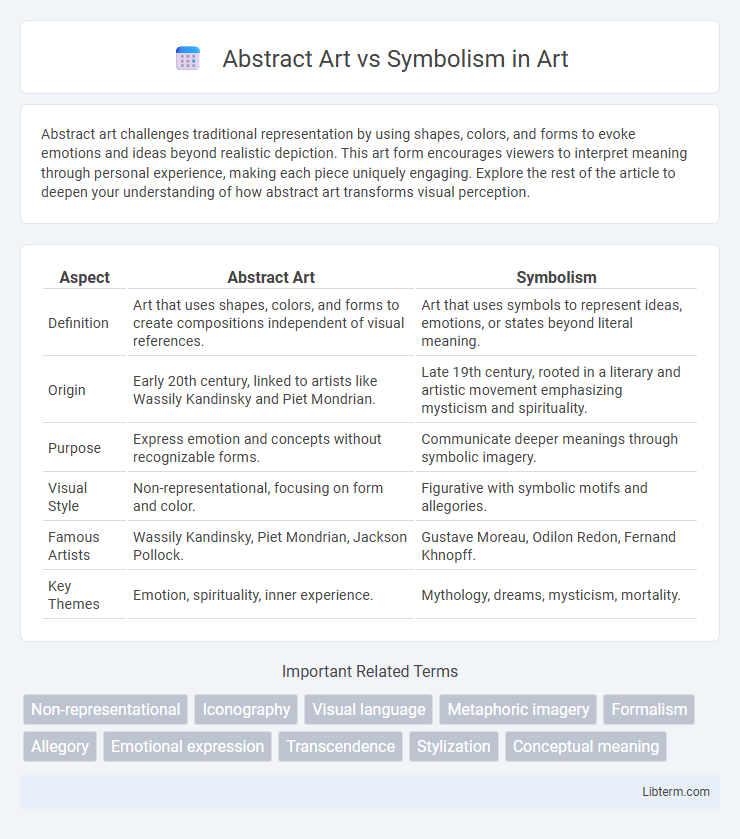Abstract art challenges traditional representation by using shapes, colors, and forms to evoke emotions and ideas beyond realistic depiction. This art form encourages viewers to interpret meaning through personal experience, making each piece uniquely engaging. Explore the rest of the article to deepen your understanding of how abstract art transforms visual perception.
Table of Comparison
| Aspect | Abstract Art | Symbolism |
|---|---|---|
| Definition | Art that uses shapes, colors, and forms to create compositions independent of visual references. | Art that uses symbols to represent ideas, emotions, or states beyond literal meaning. |
| Origin | Early 20th century, linked to artists like Wassily Kandinsky and Piet Mondrian. | Late 19th century, rooted in a literary and artistic movement emphasizing mysticism and spirituality. |
| Purpose | Express emotion and concepts without recognizable forms. | Communicate deeper meanings through symbolic imagery. |
| Visual Style | Non-representational, focusing on form and color. | Figurative with symbolic motifs and allegories. |
| Famous Artists | Wassily Kandinsky, Piet Mondrian, Jackson Pollock. | Gustave Moreau, Odilon Redon, Fernand Khnopff. |
| Key Themes | Emotion, spirituality, inner experience. | Mythology, dreams, mysticism, mortality. |
Introduction to Abstract Art and Symbolism
Abstract Art emphasizes forms, colors, and shapes detached from realistic representation, aiming to evoke emotion and conceptual ideas through non-figurative means. Symbolism, emerging in the late 19th century, relies on symbolic imagery and metaphors to convey deeper meanings, often rooted in spirituality, dreams, and the subconscious. Both movements challenge traditional art forms, with Abstract Art focusing on visual language abstraction and Symbolism prioritizing allegorical content.
Historical Origins and Evolution
Abstract Art emerged in the early 20th century with pioneers like Wassily Kandinsky and Piet Mondrian, emphasizing non-representational forms and color to evoke emotions. Symbolism originated in the late 19th century as a reaction to realism, with artists such as Gustave Moreau and Odilon Redon using symbolic imagery to express mystical and psychological themes. Both movements evolved by rejecting traditional representation but diverged in abstraction's focus on form and color, whereas Symbolism centered on metaphorical content and inner experiences.
Key Philosophies and Intentions
Abstract Art prioritizes spontaneous expression and visual elements such as color, shape, and form, aiming to evoke emotions without representing recognizable objects. Symbolism emphasizes conveying deeper meanings and allegorical content through symbolic imagery, often reflecting spirituality, mythology, and inner experiences. Both movements seek to transcend literal representation but diverge in their methods: abstraction abstracts reality to pure form, while symbolism encodes meaning through metaphorical visuals.
Notable Artists in Abstract Art
Notable artists in Abstract Art include Wassily Kandinsky, often regarded as a pioneer of pure abstraction, and Piet Mondrian, known for his geometric compositions emphasizing color and form. Kazimir Malevich introduced Suprematism, focusing on basic geometric shapes and limited color palettes, influencing modern abstraction. These artists contrast with Symbolism, which centers on representing ideas and emotions through imagery, whereas Abstract Art prioritizes visual elements like color, shape, and line over direct symbolic meaning.
Prominent Figures in Symbolism
Prominent figures in Symbolism include Gustave Moreau, Odilon Redon, and Pierre Puvis de Chavannes, who emphasized mystical themes and subjective experiences through allegorical imagery. Unlike Abstract Art pioneers such as Wassily Kandinsky and Piet Mondrian, Symbolists used evocative symbols and mythological motifs to represent deeper emotional states and spiritual realities. This movement influenced early 20th-century literature and visual arts by merging dreamlike narratives with intricate symbolism.
Visual Elements and Techniques Compared
Abstract art emphasizes color, shape, and form without representing reality, using techniques like gestural brushstrokes, layering, and non-representational compositions to evoke emotion. Symbolism employs imagery and motifs to convey deeper meanings, often integrating detailed, figurative visuals and allegorical elements with deliberate use of color and light to suggest spiritual or conceptual themes. The contrast lies in abstraction's focus on visual language divorced from concrete symbols, while symbolism depends on recognizable signs to communicate narrative or metaphysical ideas.
Themes and Meanings Explored
Abstract art explores themes of emotion, perception, and the subconscious through non-representational forms and colors, emphasizing personal interpretation and evoking mood without explicit narrative. Symbolism centers on conveying deeper meanings, myths, and spiritual ideas by using recognizable symbols and allegories to express hidden truths and mystical experiences. Both movements delve into inner realities, yet abstraction prioritizes visual sensation while symbolism focuses on metaphoric storytelling.
Audience Interpretation and Emotional Impact
Abstract art relies on non-representational forms and colors that evoke personal emotional responses, allowing viewers to project their own meanings onto the artwork. Symbolism uses recognizable symbols to convey specific ideas or themes, guiding the audience toward a more unified interpretation based on cultural or historical context. The emotional impact of abstract art is often subjective and open-ended, while symbolism tends to evoke deeper, more direct connections through its intentional use of imagery and metaphor.
Influence on Modern Art Movements
Abstract art's emphasis on visual elements such as color, shape, and form without representing real-world objects significantly influenced modern art movements like Cubism, Futurism, and Abstract Expressionism. Symbolism, with its focus on mythological and dream imagery conveying emotional and spiritual themes, paved the way for Surrealism and Expressionism by exploring inner experiences and subconscious realities. Both movements challenged traditional representation, expanding the possibilities for artistic expression in the 20th century.
Abstract Art vs Symbolism: Lasting Legacy
Abstract art revolutionized visual expression by emphasizing form, color, and emotion over representational accuracy, influencing modern art movements and contemporary design globally. Symbolism, rooted in 19th-century literature and visual arts, left a lasting legacy through its exploration of mythological themes, dreams, and the unconscious, inspiring surrealism and psychoanalytic art. Both movements reshaped artistic narratives, with abstract art advancing non-representational creativity and symbolism deepening the integration of metaphor and meaning in visual culture.
Abstract Art Infographic

 libterm.com
libterm.com